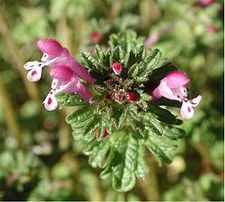- Lamiidae
-
?Lámidas
Lamium amplexicaule (Lamiaceae) Clasificación científica Reino: Plantae Clados superiores: Archaeplastida
Viridiplantae
Streptophyta
Streptophytina
Embryophyta
Tracheophyta
Euphyllophyta
Lignophyta
SpermatophytaDivisión: Angiospermae Clase: Eudicotyledoneae Clados y órdenes[2] - Lamiidae Takht. (R.G. Olmstead & W.S. Judd)[1]
- familia Boraginaceae -- Sin circunscribir a ningún orden
- familia Vahliaceae -- Sin circunscribir a ningún orden
- familia Icacinaceae -- Sin circunscribir a ningún orden
- familia Metteniusaceae -- Sin circunscribir a ningún orden
- familia Oncothecaceae -- Sin circunscribir a ningún orden
- orden Garryales
- orden Gentianales
- orden Lamiales
- orden Solanales
En Nomenclatura filogenética, las lámidas (Lamiidae) son un grupo de eudicotiledóneas que habían sido nombradas informalmente como «euastéridas I».[3] [4] El nombre «Lamiidae» fue usado por primera vez por el botánico soviético Armen Takhtajan en 1987 para denominar a un grupo que difiere en circunscripción en algunos detalles.[1] Takhtajan incluyó una descripción de las lámidas en ruso,[5] pero el nombre no fue correctamente validado hasta que el taxónomo estadounidense James Lauritz Reveal proveyera en 1993 una descripción en latín para este grupo.[6] El nombre Lamiidae fue asociado formalmente a este clado en Olmstead y colaboradores en 1992, en un trabajo en el que se afirmaba «que este clado corresponde a la subclase Lamiidae de Takhtajan...».[7] Además el nombre «lámidas» fue usado informalmente en varios tabajos de filogenia de las angiospermas.[8] [9]
El clado, según ha sido circunscripto en APG III, comprende cuatro órdenes (Garryales, Gentianales, Lamiales, Solanales) y cinco familias que todavía no han sido incluidas en ningún orden (Boraginaceae, Vahliaceae, Icacinaceae, Metteniusaceae, Oncothecaceae).[10] [2]
La sinapomorfia más evidente de las lámidas es la presencia de vasos del xilema con perforaciones simples.[11]
Referencias
- ↑ a b Lamiidae R.G. Olmstead & W.S. Judd. En: P.D. Cantino, J.A. Doyle, S.W. Graham, W. S. Judd, R.G. Olmstead, D. E. Soltis, P.S. Soltis & M.J. Donoghue. 2007. Towards a phylogenetic nomenclature of Tracheophyta. Taxon 56 (3) 822–846
- ↑ a b The Angiosperm Phylogeny Group III ("APG III", en orden alfabético: Brigitta Bremer, Kåre Bremer, Mark W. Chase, Michael F. Fay, James L. Reveal, Douglas E. Soltis, Pamela S. Soltis y Peter F. Stevens, además colaboraron Arne A. Anderberg, Michael J. Moore, Richard G. Olmstead, Paula J. Rudall, Kenneth J. Sytsma, David C. Tank, Kenneth Wurdack, Jenny Q.-Y. Xiang y Sue Zmarzty) (2009). «An update of the Angiosperm Phylogeny Group classification for the orders and families of flowering plants: APG III.» (pdf). Botanical Journal of the Linnean Society (161): pp. 105-121. http://www3.interscience.wiley.com/journal/122630309/abstract.
- ↑ Savolainen, V., M. W. Chase, C. M. Morton, D. E. Soltis, C. Bayer, M. F. Fay, A. De Bruijn, S. Sullivan, and Y.-L. Qiu. 2000a. Phylogenetics of flowering plants based upon a combined analysis of plastid atpB and rbcL gene sequences. Systematic Biology 49: 306-362
- ↑ Soltis, D. E., P. S. Soltis, M. W. Chase, M. E. Mort, D. C. Albach, M. Zanis, V. Savolainen, W. J. Hahn, S. B. Hoot, M. F. Fay, M. Axtell, S. M. Swensen, L. M. Prince, W. J. Kress, K. C. Nixon, and J. S. Farris. 2000. Angiosperm phylogeny inferred from 18S rDNA, rbcL, and atpB sequences. Botanical Journal of the Linnean Society 133: 381-461.
- ↑ Takhtajan, A. 1987. Systema Magnoliophytorum. Nauka, Leningrad.
- ↑ Reveal, J.L. 1993. New subclass and superordinal names for extant vascular plants. Phytologia 74: 178-179.
- ↑ Olmstead, R.G., Michaels, H.J., Scott, K.M. & Palmer, J.D. 1992. Monophyly of the Asteridae and identification of their major lineages inferred from DNA sequences of rbcL. Ann. Missouri Bot. Gard. 79: 249-265
- ↑ Bremer, B., Bremer, K., Heidari, N., Erixon, P., Olmstead, R.G., Anderberg, A.A., Killersjo, M. & Barkhordarian, E. 2002. Phylogenetics of asterids based on 3 coding and 3 non-coding chloroplast DNA markers and the utility of non-coding DNA at higher taxonomic levels. Molec. Phylog. Evol. 24: 274-301.
- ↑ Judd, W.S. & Olmstead, R.G. 2004. A survey of tricolpate (eudicot) phylogenetic relationships. Amer. J. Bot. 91: 1627-1644.
- ↑ P.D. Cantino, J.A. Doyle, S.W. Graham, W. S. Judd, R.G. Olmstead, D. E. Soltis, P.S. Soltis & M.J. Donoghue. 2007. Towards a phylogenetic nomenclature of Tracheophyta. Taxon 56 (3) 822–846
- ↑ Baas, P., Jansen, S. & Wheeler, E.A. 2003. Ecological adaptations and deep phylogenetic splits-evidence and questions from the secondary xylem. Pp. 221-239 En: Stuessy, T.E, Mayer, V. & Horandl, E. (eds.), Deep Morphology: Toward a Renaissance of Morphology in Plant Systematics. A.R.G. Gantner Verlag, Liechtenstein. [Regnum Veg. 141]
- Lamiidae Takht. (R.G. Olmstead & W.S. Judd)[1]
Wikimedia foundation. 2010.

